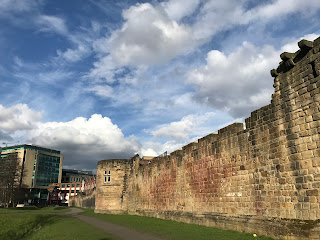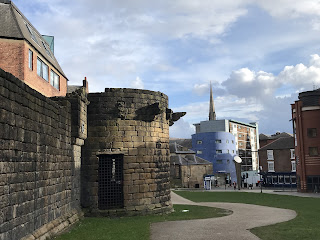When
you think of the walled cities in Britain, the ones that most commonly spring
to mind are York and Chester, however many of the more ancient cities in the UK,
like Newcastle, were at one time protected by a defensive wall. As the old saying goes – ‘If walls could
talk, what tales they would tell’, and at around seven hundred years old the
town walls of Newcastle must have quite a bit of gossip for us.
The
town wall around Newcastle was built during the 13th and 14th
centuries to defend the town from attack and occupation, during a time of hostilities
between England and Scotland. The wall
was around two miles long, varied in height from fourteen feet to twenty three
feet and was surrounded by a defensive ditch.
There was a parapet on top of the wall, seventeen towers, six main
gates, three side gates and seventeen water gates at the Quayside, allowing
access to the riverside.
On
several occasions the wall helped repel attacks by Scottish forces, but in
1644, during the Siege of Newcastle by the Scottish Covenanters, the wall was breached,
and the Scots army took control of the city and surrounding area. Once this conflict was over, the walls were
repaired and strengthened. They were further
strengthened during the Jacobite Rebellions in 1715 and 1745, as it was feared
that the Jacobite troops may invade.
However, they didn’t and in the subsequent peace the walls fell into
disrepair with some parts being demolished, and others being scavenged for
building material.
Today,
several parts of the wall remain, the best preserved of these can be found in
the west of Newcastle, in the Chinatown area.
Several of the wall towers still stand, these being Herber Tower, Morden
Tower, Ever Tower and Durham Tower.
Morden
Tower was for many years a famous literary hub and was used as a venue where many
poets and writers came to give readings of their work. Those giving readings there included Allen
Ginsberg, Seamus Heaney, Carole Anne Duffy, Ted Hughes, Roger McGough, Derek
Mahon, Brian Patten, and Stevie Smith.
On
my walk around the walls, I made my way down to Durham Tower, which is one of
the most intact of the original towers.
There, I left the Skulferatu that had accompanied me in a gap in the cement
between the stones, underneath one of the windows.
The
coordinates for the location of the Skulferatu are –
Latitude
54.971149
Longitude
-1.620655
what3words:
class.slick.bronze
I
used the following sources for information on the West Walls –
Co-Curate - Newcastle
Town Walls





























